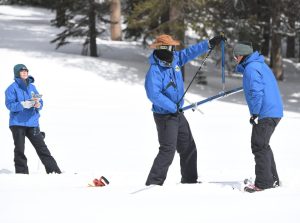Lake Tahoe, CA — California’s Sierra Nevada snowpack is estimated to be 237% of the average for the date.
Officials with the California Department of Water Resources hiked up to Phillips Station in the Lake Tahoe area this morning to conduct the April manual reading. That particular site was at 221% of the average for the date, according to DWR spokesperson Sean De Guzman, but the electronic sensors, statewide, show that the overall average is 237%.
Parsing the numbers further, the northern Sierra is 194%, the central Sierra (includes Tuolumne and Calaveras counties) is 238%, and the southern Sierra is 306%.
De Guzman says the early April reading is the “most critical measurement,” because it is when the snowpack typically reaches its peak and then begins the process of melting. California started measuring snowpack with electronic sensors in the mid-eighties, and this is the highest number recorded during that span, going back forty years.
De Guzman noted that water leaders are hoping for cool temperatures this spring so that the snow will melt gradually, instead of all at once.
DWR Director Carla Nemeth added, “The staggering amount of snowpack, and the very intense runoff conditions that we anticipate, are going to create significant challenges with long-duration flooding.”
Nemeth indicated the Central Valley, and particularly the Tulare Lake area, is of most concern.
Nemeth also adds that reservoirs across California are at 107% of average capacity, and it will continue to increase as the snow melts. Locally, Don Pedro is 114% of average, New Melones is 94%, and Lake McClure is 138%.

